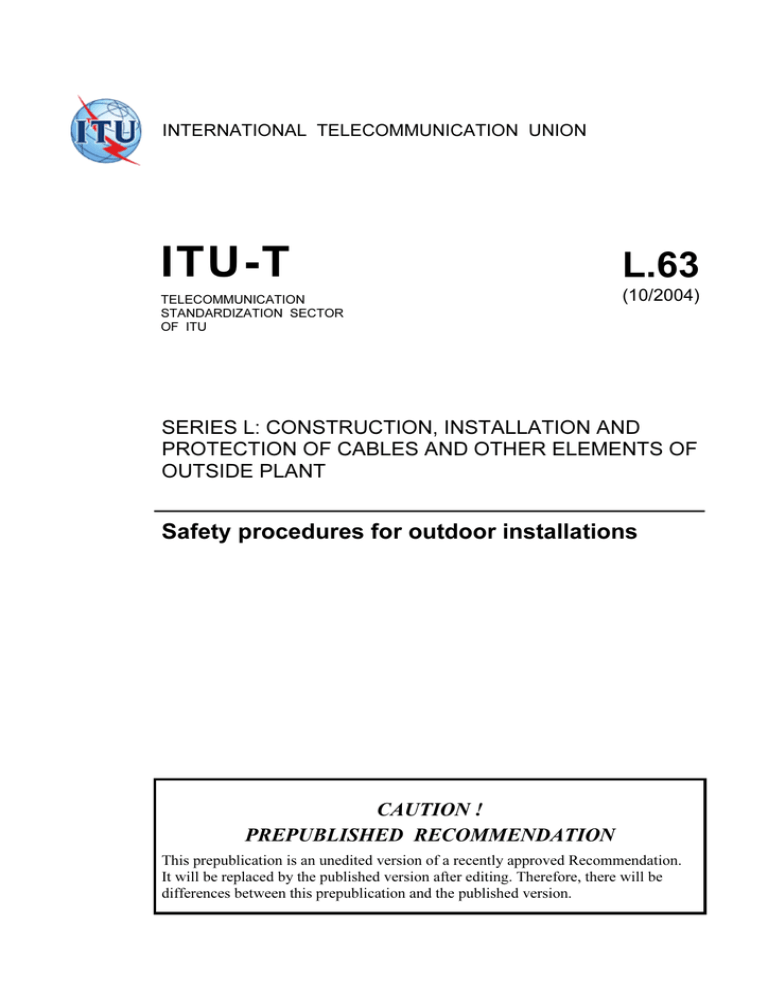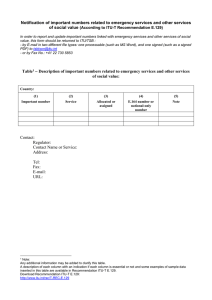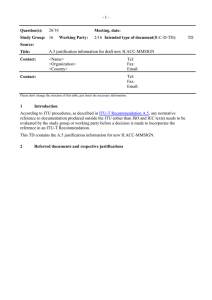
INTERNATIONAL TELECOMMUNICATION UNION
ITU-T
TELECOMMUNICATION
STANDARDIZATION SECTOR
OF ITU
L.63
(10/2004)
SERIES L: CONSTRUCTION, INSTALLATION AND
PROTECTION OF CABLES AND OTHER ELEMENTS OF
OUTSIDE PLANT
Safety procedures for outdoor installations
CAUTION !
PREPUBLISHED RECOMMENDATION
This prepublication is an unedited version of a recently approved Recommendation.
It will be replaced by the published version after editing. Therefore, there will be
differences between this prepublication and the published version.
FOREWORD
The International Telecommunication Union (ITU) is the United Nations specialized agency in the field of
telecommunications. The ITU Telecommunication Standardization Sector (ITU-T) is a permanent organ of
ITU. ITU-T is responsible for studying technical, operating and tariff questions and issuing
Recommendations on them with a view to standardizing telecommunications on a worldwide basis.
The World Telecommunication Standardization Assembly (WTSA), which meets every four years,
establishes the topics for study by the ITU-T study groups which, in turn, produce Recommendations on
these topics.
The approval of ITU-T Recommendations is covered by the procedure laid down in WTSA Resolution 1.
In some areas of information technology which fall within ITU-T's purview, the necessary standards are
prepared on a collaborative basis with ISO and IEC.
NOTE
In this Recommendation, the expression "Administration" is used for conciseness to indicate both a
telecommunication administration and a recognized operating agency.
Compliance with this Recommendation is voluntary. However, the Recommendation may contain certain
mandatory provisions (to ensure e.g. interoperability or applicability) and compliance with the
Recommendation is achieved when all of these mandatory provisions are met. The words "shall" or some
other obligatory language such as "must" and the negative equivalents are used to express requirements. The
use of such words does not suggest that compliance with the Recommendation is required of any party.
INTELLECTUAL PROPERTY RIGHTS
ITU draws attention to the possibility that the practice or implementation of this Recommendation may
involve the use of a claimed Intellectual Property Right. ITU takes no position concerning the evidence,
validity or applicability of claimed Intellectual Property Rights, whether asserted by ITU members or others
outside of the Recommendation development process.
As of the date of approval of this Recommendation, ITU [had/had not] received notice of intellectual
property, protected by patents, which may be required to implement this Recommendation. However,
implementors are cautioned that this may not represent the latest information and are therefore strongly
urged to consult the TSB patent database.
ITU 2004
All rights reserved. No part of this publication may be reproduced, by any means whatsoever, without the
prior written permission of ITU.
ITU-T Recommendation L.63
Safety Procedures for Outdoor Installations
(Geneva, 2004)
Summary
This Recommendation has the objective to establish the procedures of safety for personnel and
operation and protection against fire in outdoor telecommunications installations and in shared
infrastructures.
ITU-T Rec. L.63 (10/2004) – Prepublished version
1
CONTENTS
1
Scope
2
References
3
Infrastructure
3.1
Duct systems
3.2
Cable tunnels
3.3
Manholes
3.4
Sewage infrastructure installation
4
Outside plant network
4.1
Aerial network
4.2
Buried network
5
Outside plant equipments
6
Shared infrastructure
1
Scope
This recommendation seeks to guide the several administrations in safety procedures for personnel
and fire protection for outdoors Telecommunications installations, such as: duct systems, manholes,
tunnels, aerial, underground and buried networks, subscribers, equipments for outside plant, and
networks in sewage infrastructures.
2
References
The following ITU-T Recommendations and other references contain provisions, which, through
reference in this text, constitute provisions of this Recommendation. At the time of publication, the
editions indicated were valid. All Recommendations and other references are subject to revision;
users of this Recommendation are therefore encouraged to investigate the possibility of applying the
most recent edition of the Recommendations and other references listed below. A list of the
currently valid ITU-T Recommendations is regularly published.
The reference to a document within this Recommendation does not give it, as a stand-alone
document, the status of a Recommendation.
ITU-T Recommendation L.20- Creation of a Fire Security Code for Telecommunications Facilities
ITU-T Recommendation L.21 - Fire Detection and Alarm Systems, Detector and Sounder Devices
ITU-Recommendation L.22- Fire Protection
ITU-T Recommendation K.11- Principles of Protection Against Over Voltages and Over Currents
ITU-T Recommendation K.13- Induced Voltages in Cables with Plastics Insulated Cables
ITU-T Recommendation K.25 - Protection of Optical Fiber Cables
ITU-T Rec. L.63 (10/2004) – Prepublished version
2
ITU-T Recommendation K.26 - Protection of Telecommunication Lines Against Harmful Effects
From Electric Power and Electrified railway Lines
ITU-T Recommendation K.51 - Safety Criteria for Telecommunication Equipment
ITU- T Recommendation K.58 - EMC, resistibility and safety requirements and procedures for colocated telecommunication installations
ITU- T Recommendation K.59 - EMC, resistibility and safety requirements and procedure for
connection to unbundled cables
ITU- T Recommendation K.64 - Safe working practices for outside equipment installed in particular
environments
3
Infrastructure
For the purpose of this Recommendation infrastructure will be considered as the following outdoor
installations.
3.1
Duct Systems
Select permanent locations for underground structures considering future road developments and
plans of others utilities.
Locate manholes away from road intersections considering safety of worker and the public.
Use bottom ducts first, use outside ducts first.
In the construction or maintenance of duct lines, the projects must first be analyzed observing
rigorously all the procedures of security demanded by the administration for the workmanship and a
total knowledge that this installed in the route to be constructed or recovered.
To have to hand the complete project[BT1] of all the existing installations in the place, type of land,
adequate material of security, signalling, models of typical shoring and mechanicals equipments.
In the case of the existence of water canalization, fuel, gas, energy the required procedures of
security must be observed for each in case that, mainly observing the depths demanded for each
administration.
The use of ducts and spacers constructed of Poly(vinyl)chloride (PVC) or polyethylene (PE) and, if
possible, concrete is recommended.
For each type of installation the security procedures are restricted, depth of ditch, type of land, and
control of signalling of the performance of the worker when of its in the intervention.
3.2
Cable Tunnels
Normally cable tunnels are constructed inside the building of the telephone central office. The
systems of security are normally smoke and fire and are controlled by detectors (visible and/or
audible), fire extinguishers, and gas detection that are installed within the tunnel and the galleries,
and supervising through proper systems of detection.
It is recommended that the projected detection systems to be electrically activated use low voltage
to prevent the risk of explosion, mainly for the possibility of the existence of gases in the tunnels.
All security devices must be constantly monitored. In case of the tunnels where there exists shared
infrastructure it is recommended that each company makes the identification and that the
installations are kept of the distances appropriated.
ITU-T Rec. L.63 (10/2004) – Prepublished version
3
In the case of tunnels, cables to be next to installations of gas or the gasoline or sharing
infrastructure, it is recommended alarm devices are used for the presence of smoke, gas or gasoline.
In the tunnels of cables the same ones must be filled with earth using itself of the same point of
grounded of the central office. In all the underground splices must be filled with bonding with the
grounded of the chambers.
3.3
Manholes
When opening manholes the following considerations are recommended:
-
when opening the manhole, observe the presence of water, gasoline, fuel, etc., inside;
-
to carry thorough basic tests of gas detection;
-
to wait a minimum of 10 minutes at least before entering;
-
to keep gas detectors operational, if possible, while working inside;
-
to keep activated an audible alarm system;
-
to only use, if possible, equipment with low voltage and low current;
-
not to remain for long periods in inside of the chambers;
-
to always keep a means of fast exit from the chambers (stairs);
-
to always work with two or more workers;
-
to always maintain a system of external signalling;
-
during rain, to prevent the water entrance to the inside of chambers;
-
in the case of the use of commercial power to install a device of protection against excessive
current and voltage;
-
in all entrances of manholes, points of control for pressurization of cables must exist
3.4
Sewage Infrastructure Installations
In sewage installations, cables and components must be manufactured observing all the protection
of health for the worker against possible contamination.
The rules established by the health and environmental administrations regarding this situation must
be observed.
All workers must be oriented by specialists in health and environment.
Due to the aggressiveness of these installations, this subject will have be the object of further study.
4
Outside Plant Network
4.1
Aerial Network
For security against fire in networks’ telecommunication cables, the following considerations are
recommended:
-
To use in cables sheaths manufactured with components not flame propagating, with low smoke
and zero halogen emission environments of great agglomeration of people, such us subway or
train stations;
-
When projecting the installation of the cables or wires observing the distances of separation of
energy networks and the maximum arrow of the cable or wire in relation to the ground.
ITU-T Rec. L.63 (10/2004) – Prepublished version
4
-
The ground points must be independent of the networks of electric energy.
-
Verify a level of tension between phases.
-
It is NOT recommended to plan or install equipment that needs grounding in poles where exists
energy grounded points.
4.2
Buried Network
The minimum depth of the buried cables is typically 1,20 m.
Buried cables may be protected against keraunic activity by the installation of a copper conductor or
steel wire of 6 mm², installed approximately 600 mm above of the cable. During installation, the
cables must be placed with an indication band 200 mm above the cable.
Along of the installation may be indicated through landmarks the existence of buried cables. For
protection of them splices must be located in places of easy access.
This type of installation requires a system of efficient supervision in the direction to signal the more
correctly possible localization of damages.
5
Outside Plant Equipments
Some equipment is installed in outside plant such us subscriber multiplex, DSLAMs, amplifiers for
CATV, Subscriber Remote Units, HDSL Modems, Optical Distribution Frame, Main Distribution
Frame, and SDH MUX. Which safety and fire control must be remote and efficiently made on the
office building.
6
Shared Infrastructure
It is recommended that for shared infrastructure, protection against fire and safety are made of form
not to overlap one of the others.
The types of protections can be made of differentiated form and thus each worker can work and if to
protect inside of limit of performance.
A minimum distance between infrastructures must be observed.
ITU-T Rec. L.63 (10/2004) – Prepublished version
5
Appendix I
Ukraine Experience
Fire safety in the Duct System - Ukraine Experiences
Introduction
This Appendix contains some information about the duct system in Ukraine as well as accepted fire
safety measures in the duct system. The answers to the Questionnaire of fire safety in the duct
system are attached.
I.1
Duct system of Ukraine
The communication duct system consists of buried ducts and different types of inspection pits (e.g.
manholes, collectors, tunnels and cable chambers).
The buried ducts consist of packets of separate pipes or from multihole blocks. The maximum
capacity of duct system is 48 or 60 channels. The overall distance between some inspection pits is
150 m.
The duct materials are concrete, asbestos, polyethylene, steel and ceramic (Figure I.1).
Figure I.1. Different types of a duct (concrete, asbestos, polyethylene, steel)
The oldest constructions are the concrete blocks. The rectangular blocks by length of 1 m have one,
two or three holes (diameter -100 mm). The separate blocks are end to end combined and joined by
means of cement solution.
The most widespread constructions are asbestos ducts. The separate ducts by length of 3-6 m have
inside diameter 100 mm. The ducts are joined by means of cement solution or by ring joint.
However, the using of asbestos ducts is dangerous for health of constructing personal and
maintenance personnel. Therefore it is advised not to use this kind of materials when the new ducts
system are constructed.
Recently polyethylene ducts are applied in big cities. The separate HDPE ducts by length of 8-12
meter have outside diameter 110 mm. The ducts are joined by fusing or by ring joint.
ITU-T Rec. L.63 (10/2004) – Prepublished version
6
The short steel tubes are used for the entering ducts into the buildings. And steel tubes are applied
in free-flowing grounds. The separate ducts by length of 4-12 m have inside diameter 90-96 mm
and joined among themselves by fusing. The steel ducts are joined with asbestos ducts by means of
cement solution.
The ceramic ducts are used very rarely in the acid grounds only. The separate ducts by length of
0.9 m have inside diameter 100 mm.
The main type of inspection pit is a manhole. The reinforced concrete (entire or composite)
manholes and brick manholes are used. Three types of manholes are applied: feed-through, angular,
splitter (Figure I.2).
Figure I.2. Building blocks of a communication duct
Composite reinforced concrete manholes are most widespread. They consist of lower wall ring with
the bottom and upper wall ring with overlap.
Brick manholes are less reliable and more permeable for gases and water. However it is easy to
construct the manhole of any shape and dimensions. This is important where the duct system is
under construction near some utilities or buildings.
The pig-iron hatches are built in manholes for input (Figure I.3). The inlet diameter is 600 mm. The
hatch consists of pig-iron frame, pig-iron upper cover and steel lower cover. The lower cover has
fitting for hanging of lock. Both covers have apertures for gas control without unclosing of covers.
The mass of hatch is 138 kg (heavy type) or 82 kg (light type).
ITU-T Rec. L.63 (10/2004) – Prepublished version
7
Figure I.3. The pig-iron hatch
There are cantilever hooks arrange in the manholes for layout of cables. There are cantilevers and
cantilever hooks in the manholes for arrangement of cables (figure I.4).
Figure I.4. Pig- iron cantilever hooks
The collector (figure I.5) is underground room for a share locality of elements of different services
(communication cables, electric power cables, hot-water pipes, steam conduits, air flow guides,
drains pipelines and low pressure gas pipelines).
The depth of presence (finding) of collectors is 1 - 1.2 m from a ground surface. The in-house
overall dimensions are: width - 1.7-2.7 m, height - 1.8-3.0 m.
ITU-T Rec. L.63 (10/2004) – Prepublished version
8
Figure I.5 - Underground collector
In some cities the communication optical fibre cables are installed in tunnels of subway. They
dispose on cantilever hooks of a special construction. In the passenger stations these cables are laid
under platform and put into tunnel through vertical well holes. In the well holes the cables are
attached to wall by special metal clamps.
I.2
Fire safety measures in manholes, collectors and tunnels
Before the starting of operations in manhole and collectors the check of presence of gas should be
executed by gas-analyser. When the gas is presented electrical ventilator should execute the
compulsory ventilation. When the gas is absent the natural ventilation should be executed through
open ducts.
The metal instruments covered by copper should be applied for opening the manhole cover. In
winter when the cover freezes to frame of hatch the hot sand should be applied for opening the
manhole cover.
For operating in the manhole the crew of not less than two men should be used. One man should
stay outside of manhole always.
The illumination of manholes and collectors should be produced by low voltage (12V). The low
voltage accumulators or portable batteries may also be used.
It is forbidden to use an open flame in manholes and collectors.
In collectors and tunnels it is forbidden to touch with power cables and to lay instruments and
materials on these cables.
In tunnels the fire retardant cables should be applied only. These cables may use the PVC, LSOH or
other non-inflammable sheaths. In subway tunnels the hot sensor units are installed. The hot sensors
and the smoke sensors are installed in each station. The fire hydrants and hand-operated carbon fire
extinguishers are also install in each station.
ITU-T Rec. L.63 (10/2004) – Prepublished version
9
Appendix II
Brazilian Experience
Safety of Personnel for Installation in Infrastructures of Power Lines
Distribution
The following points were excerpts from the Brazilian regulation on this issue, and considered
relevant.
•
Is not recommended the installation of telephones cables in infrastructure of electric power with
voltage higher than 75 kV.
•
It is not recommended the project of telephones networks in lines parallel with electric power
networks with nominal voltage higher than 35 kV.
•
The ground resistance must be the maximum of 13 Ω.
•
The followings distances between networks are recommended:
Voltage (V)
Minimum
Distance (m)
Up 600
0,60
Of 600 a 15000
1,30
of 15000 a 35000
1,80
of 35000 a 70000
2,20
•
In the crossings of telephone networks and electrical power networks of up to 70 kV, must be
observed a 90º±15° angle.
•
In the crossings of telephone networks and electrical power networks with voltage between 35
kV and 70 kV, the messenger must be grounded in both sides of the electric line, with a
maximum ground resistance of 30 Ω.
_________________
ITU-T Rec. L.63 (10/2004) – Prepublished version
10


